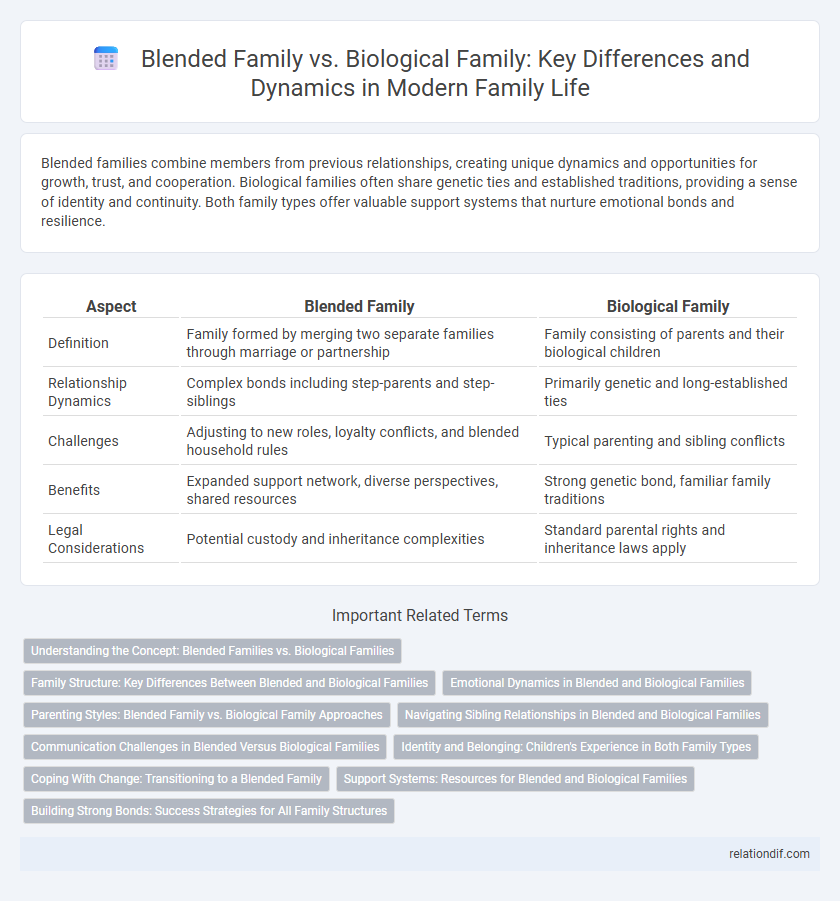Blended families combine members from previous relationships, creating unique dynamics and opportunities for growth, trust, and cooperation. Biological families often share genetic ties and established traditions, providing a sense of identity and continuity. Both family types offer valuable support systems that nurture emotional bonds and resilience.
Table of Comparison
| Aspect | Blended Family | Biological Family |
|---|---|---|
| Definition | Family formed by merging two separate families through marriage or partnership | Family consisting of parents and their biological children |
| Relationship Dynamics | Complex bonds including step-parents and step-siblings | Primarily genetic and long-established ties |
| Challenges | Adjusting to new roles, loyalty conflicts, and blended household rules | Typical parenting and sibling conflicts |
| Benefits | Expanded support network, diverse perspectives, shared resources | Strong genetic bond, familiar family traditions |
| Legal Considerations | Potential custody and inheritance complexities | Standard parental rights and inheritance laws apply |
Understanding the Concept: Blended Families vs. Biological Families
Blended families combine members from previous relationships, creating unique dynamics that differ from traditional biological families where all members share a direct genetic bond. This structure often requires navigation of complex relationships and adjustment to new roles among step-parents, step-siblings, and biological children. Understanding the distinctions helps foster emotional support and effective communication within diverse family units.
Family Structure: Key Differences Between Blended and Biological Families
Blended families consist of members from previous relationships, creating a dynamic family structure where step-parents and step-siblings interact alongside biological ties. Biological families are typically defined by genetics and shared ancestry, fostering inherently connected relationships based on blood relations. The key difference lies in the integration and formation of new bonds within blended families, contrasting with the traditionally straightforward lineage of biological families.
Emotional Dynamics in Blended and Biological Families
Emotional dynamics in blended families often involve navigating complex relationships as members integrate diverse backgrounds and previous attachments, requiring heightened communication and adaptability. Biological families typically experience more stable emotional connections due to shared history and genetic ties, though challenges like sibling rivalry and parental expectations remain. Understanding these distinctions helps address emotional needs uniquely, fostering healthier relationships in both family structures.
Parenting Styles: Blended Family vs. Biological Family Approaches
Parenting styles in blended families often require greater flexibility and communication to address the unique dynamics of stepchildren and stepparents, whereas biological families typically rely on established routines and shared history. Blended family parents tend to emphasize cooperative co-parenting and adaptability to build trust and stability, contrasting with the more consistent disciplinary approaches found in biological family settings. Understanding these differences is crucial for fostering healthy relationships and effective parenting in diverse family structures.
Navigating Sibling Relationships in Blended and Biological Families
Navigating sibling relationships in blended and biological families requires understanding distinct emotional dynamics and communication patterns. Biological siblings often share a lifelong bond rooted in shared history, while blended siblings must build trust and connection amidst new family structures. Effective conflict resolution and fostering open dialogue are crucial for strengthening these relationships in both family types.
Communication Challenges in Blended Versus Biological Families
Blended families often face complex communication challenges due to differing parenting styles, loyalty conflicts, and varied family histories, which can create misunderstandings and tension. In contrast, biological families usually have more established communication patterns and shared experiences, facilitating smoother interactions. Effective communication strategies in blended families require intentional efforts to foster trust, address emotional adjustments, and create a unified family identity.
Identity and Belonging: Children's Experience in Both Family Types
Children in blended families often navigate complex identities as they reconcile relationships with stepparents and half-siblings, influencing their sense of belonging and emotional security. In biological families, identity formation tends to be more straightforward, grounded in shared genetics and long-established family traditions. Research shows that fostering open communication and inclusive family rituals enhances belonging and identity development in both family types.
Coping With Change: Transitioning to a Blended Family
Transitioning to a blended family involves navigating complex emotional dynamics and redefining family roles to foster harmony among all members. Effective communication, patience, and establishing new traditions help in coping with changes and building strong bonds between stepparents, stepchildren, and biological parents. Supportive counseling and open dialogue reduce conflicts and promote a sense of belonging in the evolving family structure.
Support Systems: Resources for Blended and Biological Families
Blended families often benefit from tailored support groups, counseling services, and community programs addressing unique dynamics like step-parenting and co-parenting challenges, which differ from those commonly found in biological families. Biological families typically have access to established resources such as genetic counseling, heritage-based support networks, and long-standing social connections that reinforce familial bonds. Both family types increasingly utilize online platforms and therapy options to strengthen relationships and provide emotional support adapted to their specific needs.
Building Strong Bonds: Success Strategies for All Family Structures
Building strong bonds in both blended and biological families requires open communication, consistent quality time, and mutual respect among all members. Engaging in shared activities and creating new family traditions help establish trust and a sense of belonging, regardless of family structure. Emotional support and adaptability are key success factors that foster resilience and unity in diverse family dynamics.
blended family vs biological family Infographic

 relationdif.com
relationdif.com